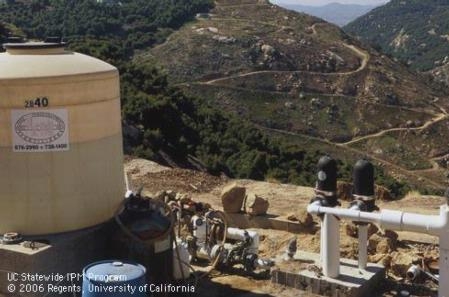Nutrient availability from organic sources has been considered “slow release” by many growers and advisers. This may be true in environments are colder and especially soils are cooler. Organic nutrients are dependent on microbes to break down materials and release those nutrients, and when soils are cold, microbes can't do their thing. Soils in much of agricultural California tend to be warm and lack the freezing conditions that occur in many soils in the continental US. Imagine how much microbial activity occurs in the Mid-West when soils cool down to 32 deg F at a four inch depth and deeper. The top layers of soil are where organic matter accumulates and where most microbial activity occurs. When soils cool below 50 deg F, nitrogen leaching becomes less common, because less activity is occurring which also coincides with much less plant growth.
Soils in coastal California rarely fall below 50 deg F in the surface layers, so microbial activity is ongoing, all year long. So the question is, how “slow acting” are organic fertilizers? A recent study by Tim Hartz, Richard Smith and Mark Gaskell looked at release rates of injectable organic fertilizer and found that much of the nutrient release occurs within about a week after application depending on the formulation and temperature during the study. The results conform to another study that they did where they evaluated the nitrogen release rates of dry formulations of organic fertilizers – compost, manures, feather meal, etc.
Aside from the issues of the higher costs of these materials and their potential clogging, there is the issue of application timing. In the case of avocados and citrus, adequate levels of nitrogen are needed in the trees going into to fruit set in order to optimize set. And then after fruit set, in order to maintain growth into the fast growth period, again nitrogen needs to be adequate. Using organic fertilizers with a rapid conversion to useable forms of nitrogen, means that application timing should coincide with these critical periods in tree phenology or growth cycle.
Using information on organic nutrient management based on work from cold soil climates needs to be carefully evaluated before applying it to California soils. One of the most common problems in organic production is nitrogen management. Part of the problem is the cost of supplemental nitrogen amendments, but also learning to anticipate when that applied nutrient becomes available to the plant. Developing better estimates for local release rates and patterns will better help manage organic nutrient sources.
Read more:
Nitrogen Availability from Liquid Organic Fertilizers by T.K. Hartz, R. Smith and M. Gaskell
http://horttech.ashspublications.org/content/20/1/169.full
Summary: Limited soil nitrogen (N) availability is a common problem in organic vegetable production that often necessitates additional N fertilization. The increasing use of drip irrigation has created a demand for liquid organic fertilizers that can be applied with irrigation. The N availability of three liquid organic fertilizers was evaluated in an incubation study and a greenhouse bioassay. Phytamin 801 contained fishery wastes and seabird guano, while Phytamin 421 and Biolyzer were formulated from plant materials. The fertilizers ranged from 26 to 60 g·kg−1 N, 8% to 21% of which was associated with particulate matter large enough to potentially be removed by drip irrigation system filtration. The fertilizers were incubated aerobically in two organically managed soils at constant moisture at 15 and 25 °C, and sampled for mineral N concentration after 1, 2, and 4 weeks. In the greenhouse study, these fertilizers and an inorganic fertilizer (ammonium sulfate) were applied to pots of the two organically managed soils with established fescue (Festuca arundinacea) turf; the N content of clippings was compared with that from unfertilized pots after 2 and 4 weeks of growth. Across soils and incubation temperatures, the N availability from Phytamin 801 ranged from 79% to 93% of the initial N content after 1 week, and 83% to 99% after 4 weeks. The plant-based fertilizers had significantly lower N availability, but after 4 weeks, had 48% to 92% of initial N in mineral form. Soil and incubation temperature had modest but significant effects on fertilizer N availability. Nitrification was rapid, with >90% of mineral N in nitrate form after 1 week of incubation at 25 °C, or 2 weeks at 15 °C. N recovery in fescue clippings 4 weeks after application averaged 60%, 38%, and 36% of initial N content for Phytamin 801, Phytamin 421, and Biolyzer, respectively, equivalent to or better than the N recovery from ammonium sulfate.
Attached Images:
